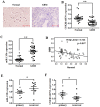miR-135b contributes to the radioresistance by targeting GSK3β in human glioblastoma multiforme cells
- PMID: 25265336
- PMCID: PMC4181861
- DOI: 10.1371/journal.pone.0108810
miR-135b contributes to the radioresistance by targeting GSK3β in human glioblastoma multiforme cells
Abstract
Radioresistance remains a major challenge in the treatment of glioblastoma multiforme (GBM). Recent data strongly suggests the important role of miRNAs in cancer progression and therapeutic response. Here, we have established a radioresistant human GBM cell line U87R derived from parental U87 and found miR-135b expression was upregulated in U87R cells. miR-135b knockdown reversed radioresistance of U87R cells, and miR-135b overexpression enhanced radioresistance of U87 cells. Mechanically, bioinformatics analysis combined with experimental analysis demonstrated GSK3β (Glycogen synthase kinase 3 beta) was a novel direct target of miR-135b. Moreover, GSK3β protein expression was downregulated in U87R cells and restored expression of GSK3β increased radiosensitivity of U87R cells. In addition, clinical data indicated that the expression of miR-135b or GSK3β was significantly association with IR resistance of GBM samples. Our findings suggest miR-135b is involved in the radioresistance of human GBM cells and miR-135b-GSK3β axis may be a novel candidate for developing rational therapeutic strategies for human GBM treatment.
Conflict of interest statement
Figures





References
-
- Louis DN (2006) Molecular pathology of malignant gliomas. Annu Rev Pathol 1: 97–117. - PubMed
-
- Stupp R, Mason WP, van den Bent MJ, Weller M, Fisher B, et al. (2005) Radiotherapy plus concomitant and adjuvant temozolomide for glioblastoma. N Engl J Med 352: 987–996. - PubMed
-
- Sulman EP, Guerrero M, Aldape K (2009) Beyond grade: molecular pathology of malignant gliomas. Semin Radiat Oncol 19: 142–149. - PubMed
-
- Liu Q, Tang H, Liu X, Liao Y, Li H, et al. (2014) miR-200b as a prognostic factor targets multiple members of RAB family in glioma. Med Oncol 31: 859. - PubMed
-
- Noda SE, El-Jawahri A, Patel D, Lautenschlaeger T, Siedow M, et al. (2009) Molecular advances of brain tumors in radiation oncology. Semin Radiat Oncol 19: 171–178. - PubMed
Publication types
MeSH terms
Substances
LinkOut - more resources
Full Text Sources
Other Literature Sources
Miscellaneous

